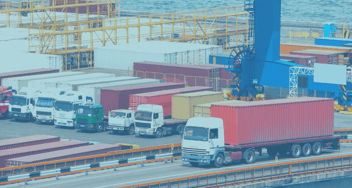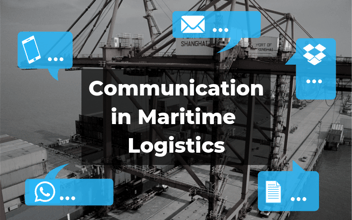What is Blank Sailing? + How to Avoid its Consequences
Container shipping operations
Your shipment has been packed and the container is waiting at the port to be loaded onto a ship. But, the day before this is to happen, you get notified that the vessel has blank sailed. It’s a frightening thought – a delayed shipment could cost you the customer’s loyalty.
Unfortunately, blank shipping is fairly common. At the height of the coronavirus pandemic in May 2020, there were 263 blank sailings reported. Though the numbers have fallen since then, May 2021 still saw 122 blank sailings.
Blank sailings may be planned or unplanned and could occur for a variety of reasons. Understanding the circumstances in which shippers resort to blank sailings can help you plan quicker responses and maintain control over your delivery timelines.
What is Blank Sailing?
Blank sailings or Void sailings refer to instances in which a carrier skips one or more ports on the scheduled route.
Let’s say a ship is traveling from Hamburg to Jeddah with planned stops at Rotterdam, Felixstowe, Le Havre, Valencia and Port Said on route. If the ship does not stop at Valencia but moves directly from Le Havre to Port Said, Valencia would be marked as ‘blank sailing’. Any cargo that was to be loaded onto the vessel at Valencia will now have to be scheduled for another vessel going in the same direction. Similarly, cargo to be offloaded at Valencia may have to be offloaded at a port before.
Blank sailing is not only inconvenient, but it can also be expensive once you consider demurrage and detention charges.
Why do Blank Sailings Happen?
There are many reasons for blank sailings. Here are the top 6.
Maintaining deadlines
Every ocean vessel has a fixed number of days to complete the schedule between two ports and return to its base. Every time it stops at an intermediate port, it is allotted a certain number of days for the unloading and loading operation. If the ship exceeds this time frame at a particular port, it may decide to skip the next port so as to maintain overall schedule integrity and reach the main hub on time. If the ship did not skip a port, it would risk late arrival and, in turn, tarnish its reputation.
Low demand for container space
The number of containers being loaded at each port is different. Sometimes, if a ship is delayed at port A and it has very few containers to be loaded at port B, it may skip port B to make up time. Low demand for container space is one of the most common reasons for blank sailings. This is often seen just after the holiday season.
Blank sailings caused by low demand also help carriers consolidate shipments and thus make their operations more cost-effective. Some carriers may also use the opportunity to increase freight rates.
Port congestion
Port congestion is a common issue with maritime logistics. If there are too many ships at a port, the ship with your container may have to wait outside at anchorage until there is sufficient space to berth. Other reasons for port congestion could be labor strikes, poor infrastructure at the ports, slow customs processes, accidents, political events, etc.
The wait to get to the front of the line can be quite long and it may be difficult to estimate when the ship can start unloading containers. To avoid these long waits, ships may choose to skip the port and reroute their trip. Or they may unload in a port nearby that is less congested and bring the goods to the more crowded port by a small feeder so the original port doesn’t block up the large carrier.
Bad weather
Let’s say the next port that the ship is supposed to berth at has received a storm warning. If the ship stays true to its course and schedules a stop at the port, there’s a risk that it may be held up indefinitely until the storm abates. This would delay their arrival at all the other ports ahead. Hence, in such cases, many shippers choose to blank sail the port. Alternatively, they may have to wait out a storm at the port they are currently berthed and cancel their stops ahead.
Mechanical issues
Ultimately, ships are highly sophisticated floating machines and like all machines, they are subject to wear and tear. At times, they may have mechanical issues that require urgent repairs. This extends their stay at a particular port and to make up time on their schedule, they may skip the next port. Think of it as a car with a flat tire – you can’t keep driving, you have to stop and get the tire changed…
Changing Regulations
All ships sailing across the ocean must comply with certain global maritime regulations. New rules and changes implemented by regulatory authorities can lead to blank sailings. For example, in January 2020, a new rule instructed all ships to be equipped with Exhaust Gas Cleaning Systems to reduce the sulfur content in marine fuels. Many vessels had to be berthed for the modifications resulting in numerous blank sailings.
How does Blank Sailing Affect You?
Blank sailings affect big and small customers alike. Here’s an idea of the issues it could result in:
Supply Chain Turmoil
If you have a shipment waiting to be loaded or unloaded at a port that the vessel sailed past, your supply chain could be brought to a halt. The correct way for a carrier to manage a blank sailing is to unload the cargo on the port before the blank sailing to ensure that the ship of the same service can take the cargo the week after. When a carrier manages a blank sailing in the best way, shouldn’t be delayed for more than a week, but even this can still be a disaster for your supply chain.
It could be days or weeks before you find another vessel to transport your shipment. This is particularly problematic to customers following a lean Just-In-Time supply chain. On one hand, there may be a time when store shelves are empty because the shipment has been delayed. On the other hand, the delayed and next shipment may arrive together resulting in overstocks.
Increased Cost of Operations
When stores are faced with overstocks, they may have to temporarily rent additional warehousing space from a third-party service provider. This instantly increases operational costs and reduces your profit margin. If the shipment is time sensitive like fresh agricultural produce, the entire shipment may have to be written off as a loss.
Suspended Production
For the manufacturing industry, blank sailings could halt production. For example, if the delayed shipment included raw materials, the production line would need to stop and wait till it was delivered. Similarly, cargo intended for specific events such as shows will be of no use if they are delivered after the event.
Thus, it is important to be aware of blank sailings and take proactive measures to protect yourself from them.
How to Avoid Blank Sailing Consequences
Shipping companies are bound to inform customers of blank sailings. These alerts can help you negate the effects of blank sailings if you react quickly enough. Your ability to do this relies on what you have planned for. Here are a few tips:
Assess Vessel Reliability Before Booking
The first step to protecting yourself against blank sailings is to partner with a shipping company that isn’t likely to skip your port. One way to assess this is to look at the carrier’s history of blank sailings in the past. If there’s been blank sailing in the past, there’s a higher chance it may happen again. This historic information can be accessed on container shipping management platforms like BuyCo.
BuyCo assesses historic and real-time data from 97% of all ocean carriers to calculate realistic ETAs/ ETDs. By making schedule information from multiple shippers available on a common platform, BuyCo makes it easier for you to compare services and choose the most reliable carrier.
Have a Plan B
As mentioned above, some causes for blank sailing are beyond the shipper’s control. For example, many carriers have had to alter routes and suspend bookings at ports as a result of the escalating Russia-Ukraine conflict. Thus, you need to have a backup plan in place.
In such situations, you may use alternative transport arrangements such as moving the shipment by road, rail or air depending on its nature and commitment made to the market. While it may seem more expensive, when compared to the loss of revenue caused by delayed shipments and the additional demurrage and detention charges, this may be a wiser solution.
Track Containers Independently
Shipping companies will inform you of blank sailings, but this may not always be in time for you to react. Thus, you need to have independent end-to-end visibility of your container movement.
BuyCo gives you a realistic ETA at your chosen port of discharge and simultaneously sources data from multiple points to track your container. Let’s say the ship’s planned ETA at a port is September 15th. But, the tracking data says that it has been held up at an earlier port and will not reach the port before September 20th. This implies a high risk of the ship skipping the planned stop at your port of loading. In such cases, you can act proactively and rebook your shipment on another carrier.
Summing Up Blank Sailings
Whether you’re transporting food, furniture or raw materials, blank sailings can through your supply chain into disarray. Even the best. Most reliable shippers may need to look at the bigger picture and skip intermediate ports from time to time. Hence, this circumstance is not completely avoidable. You need to understand the risk and have a crisis management plan in place.
Container shipping management platforms like BuyCo are a big help in this regard. From the time you’re comparing carrier rates, schedules and their history of making timely deliveries to tracking your shipment and adjusting the plan as required, BuyCo consolidates multiple functions onto a single platform. It gives you the necessary tools to plan ahead and take measures to minimize the loss caused by blank sailings.
Learn more about BuyCo and the role it can play in your logistics management


